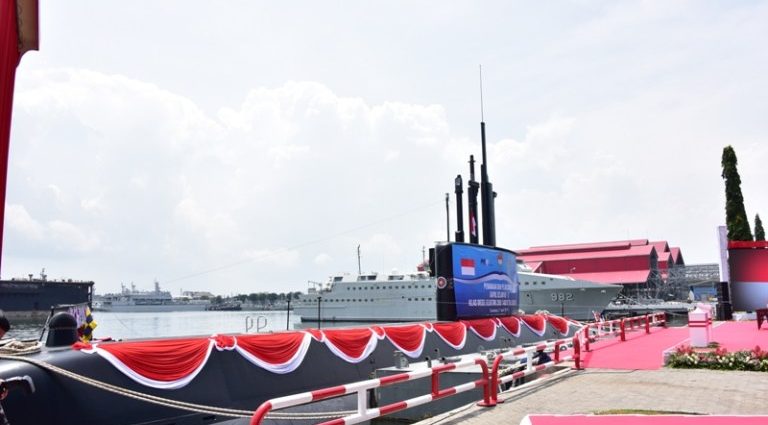
Indonesia is planning to spend big on building its submarine fleet with France’s help, potentially nixing its long-standing defense partnership with South Korea in that area.
This month, defense resource Janes reported that the Indonesian Ministry of Finance has approved the Ministry of Defense’s request for US$2.16 billion in foreign loans to fund the submarine acquisition program.
A declassified letter obtained by Janes during this month’s International Maritime Defense Exhibition and Conference (IMDEX 2023) notes that Indonesian Finance Minister Sri Mulyani Indrawati referenced a request from Defense Minister Prabowo Subianto laying out a list of 25 military procurement programs for which foreign loans have been proposed as the source of funding for 2023.
The source says the letter mentions two air-independent propulsion (AIP) submarines with an underwater displacement of 1,800 and 2,800 tons, with funding covering logistics and maintenance packages, training, and shipbuilding technology transfer costs.
Regarding what type of submarines Jakarta is planning to acquire, Asia Times reported in March 2022 that the Indonesian Navy had announced plans to acquire two of France’s Scorpene-class subs, formalizing an agreement that in effect drops South Korea as Indonesia’s primary partner in maintaining its submarine fleet.
That happened despite an April 2019 procurement agreement between Indonesia’s Ministry of Defense and South Korean shipbuilder Daewoo Shipbuilding and Marine Engineering (DSME).
Last February, Indonesian shipbuilder PT PAL and France’s Naval Group signed a preliminary agreement to collaborate on building two Scorpene submarines and establish a joint research and development facility in Indonesia. That agreement was made to facilitate the integration of weapons and systems aboard the submarines, provision for training and operations, construction and sustainment, and technology transfer.
Submarines may offer outsize capability benefits for navies on a tight budget, something Indonesia may know about.
Muhammad Malufti and Alban Sciascia note in a January 2022 article for The Diplomat that technological advancements such as long-range precision-guided munitions (PGMs) have made it possible for adversaries to strike at Indonesia without even entering its exclusive economic zone (EEZ), making it imperative for the Indonesian Navy to have power projection capabilities to seek and destroy such enemies.
However, Malufti and Sciascia say Indonesia does not have the resources to build a blue-water navy and hence must prioritize cost-effective solutions, noting that submarines may be the best asset for the job.
They note that submarines can provide greater deterrence than other naval assets due to their inherent stealth and that Indonesia must acquire newer models featuring politically and financially viable technologies, such as lithium-ion batteries, very low frequency (VLF) communications systems, and submarine-launched anti-ship missiles.
Malufti and Sciascia also point out the Indonesian Navy’s extensive experience operating submarines, having done so since 1959, with its subs patrolling its waters for more than six decades. It sent two of its Soviet-made Whiskey-class submarines to support Pakistan in the 1965 India-Pakistan War, and in 1999 one of its German-made Type 209 submarines shadowing the International Force East Timor fleet.
They also say that a submarine program will help Indonesia’s domestic shipbuilding industry, with submarine maintenance, repair, and overhaul included in the country’s defense priority programs, with PT PAL having demonstrated the capability to assemble the KRI Alugoro with parts from South Korea and overhaul the German-made KRI Cakra.
However, Indonesia faces significant challenges when it comes to building submarines. In a February article for Defense News, Mike Yeo notes that there are big questions about PT PAL’s capability to do such, saying that the commander of the ill-fated KRI Nanggala had pointed out the shipbuilder’s substandard maintenance on that submarine alongside shoddy work on the KRI Alugoro.
Yeo says that may be due to the hodgepodge character of Indonesia’s submarine program, with German, South Korean, French, and domestic players making integrating systems across different ship designs challenging. In addition, he says Indonesia’s shipbuilding industry may struggle with building submarines as it needs more know-how, and Indonesia needs more capable domestic players in that area.
Indonesia’s abrupt decision to drop South Korea as its leading submarine program partner may have huge regional implications in the Pacific.
Alexander Hynd and Max Broad write in a February article in The Interpreter that the April 2021 loss of KRI Nanggala may have contributed to Indonesia’s doubts about its defense partnership with South Korea, as the submarine undertook a refit there in 2012.
Hynd and Broad also say Indonesia is reportedly unsatisfied with the performance of its Korean-built submarines and that Indonesia is seeking ways to reduce its procurement costs by looking at other partners.
Hynd and Broad say DSME runs substantial financial risks for South Korea should its submarine agreement with Indonesia fall through. They note that DSME has already pre-ordered parts for Indonesia’s submarine purchase, and South Korea has expressed frustration with Indonesia’s lack of financial follow-through with their April 2019 agreement.
They noted similarities between Indonesia’s and Australia’s sudden decisions to drop South Korea and France as their primary partners for their respective submarine programs, resulting in diplomatic fallout and loss of trust that could hamper future defense cooperation between the two regional powers.
Hynd and Broad also said the quick settlement of the tentative April 2019 submarine agreement between Indonesia and South Korea would provide Jakarta with a clean slate for relations with Seoul and clarify its naval modernization plans.
In addition, they say the timely resolution of the issue will allow South Korea to consolidate its New Southern Policy, which emphasizes building economic and political links with the Association of Southeast Asian Nations, and promote its push as an alternative arms provider free from the political strings attached to US, Chinese, or Russian weapons.

